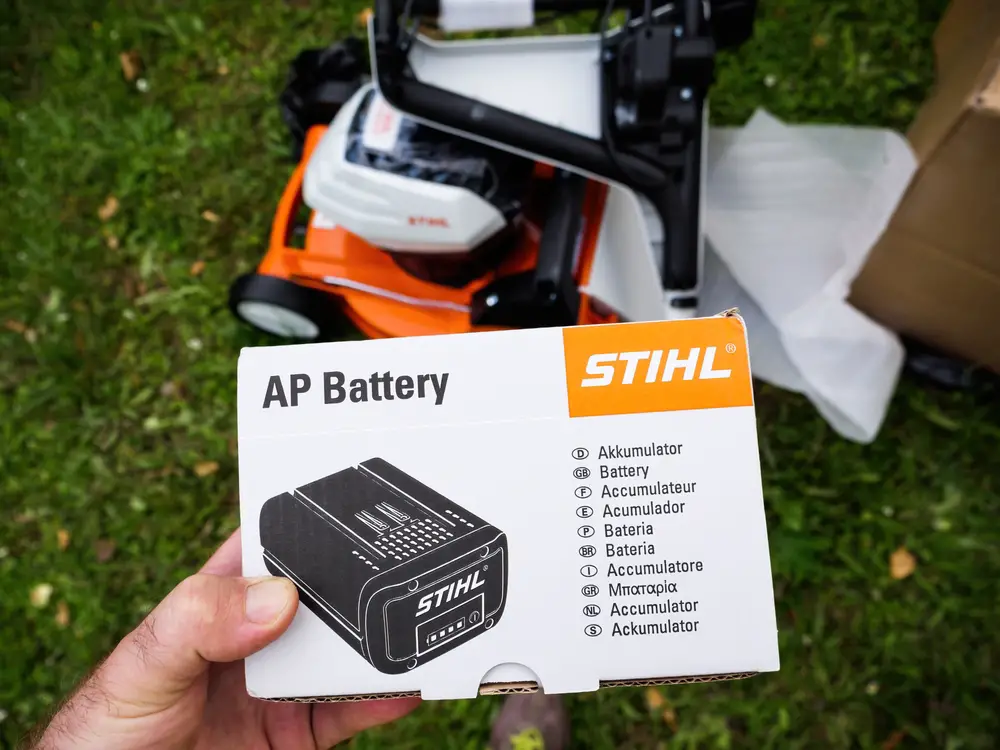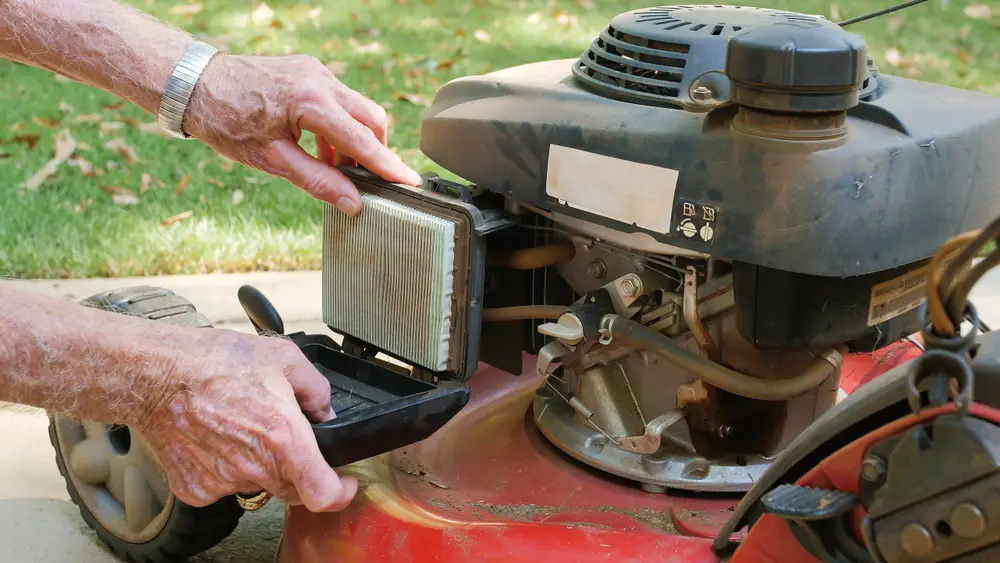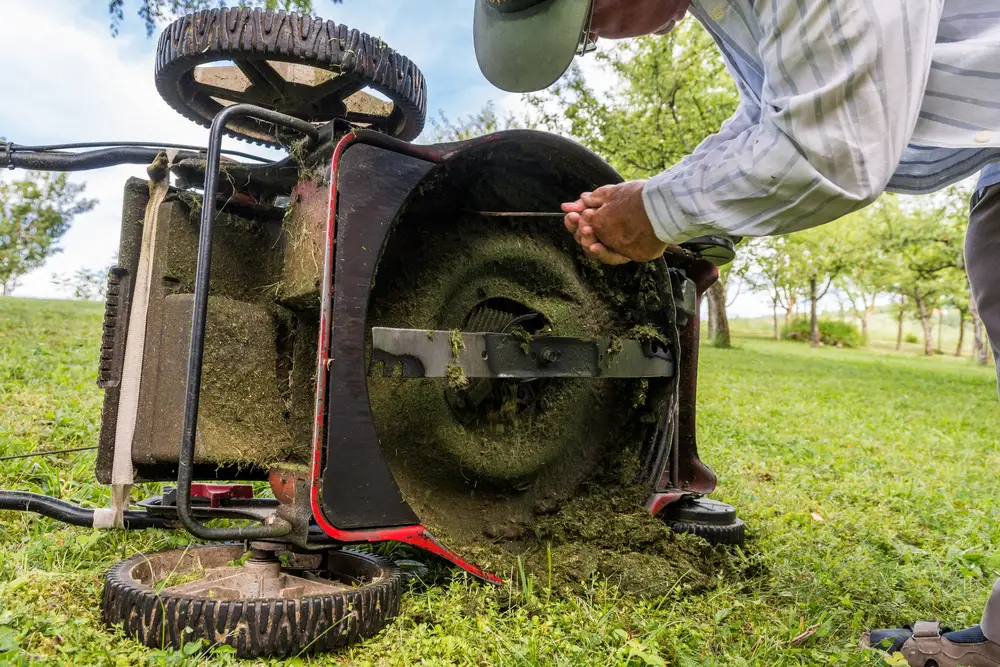For many homeowners, autumn stirs thoughts of storing the lawnmower. While your manual will indicate the best storage methods, you may also need to consider an annual maintenance schedule to allow your lawnmower to continue running efficiently and safely. Read on to learn how to store a lawnmower for the winter.
How to Store a Lawnmower in the Winter
These are steps that you need to take when storing your lawnmower over the winter. Each step is crucial in ensuring the lawnmower remains in good working order. Remember, this is a machine, and improper maintenance can have serious consequences. Plus, you want your lawnmower to last.
1. Prepare the Mower for Maintenance
Place your mower on a flat or level surface. Turn the engine off and ensure it is completely cool before moving on to the next step. Once thoroughly cooled, disconnect the ignition wire of the spark plug.
2. Drain the Fuel
The main reason people have challenges starting the mower come spring is the stale gas left behind. Either run the mower to rid it of excess fuel or drain the fuel from the tank. Then, use a fuel stabilizer and add it to the fresh fuel while filling the tank.
To prevent stale gas, add quality fuel stabilizers which keeps gas fresh for up to two years. It prevents old fuel from becoming gummy in the carburetor while not being used, which is essential when storing your lawnmower.
Run your lawnmower to distribute the stabilizer through the fuel system. Turn your mower off, allowing it to cool. Siphon leftover gas into a clean can. Restart your lawnmower and keep it running until it stops. Repeat the process until your engine isn’t starting and your fuel lines are completely empty.
3. Disconnect the Spark Plug

Before continuing to the rest of the step, disconnect the spark plug to prevent your mower from accidentally kick-starting, potentially causing serious injuries.
Take this opportunity to check the spark plug. If the spark plug is damaged or worn, replace it. The operator’s manual will contain the appropriate part number.
To remove it, use a socket wrench and a spark-plug socket. It should have a neoprene lining protecting the porcelain casing. Even if your spark plug is in decent shape, the new one performs better and only costs a few dollars. It will give you a smoother start when spring arrives.
4. Remove the Battery

If there is a battery, remove it by following the instructions for your lawnmower. You will need to store riding mower batteries in a dry and cool location.
5. Drain Oil
Changing the oil ensures your lawnmower remains in excellent condition during winter storage. To change the oil, follow these instructions:
- If you have a 4-cycle engine, you need to do an oil change. Some trimmers and lawn mowers contain 2-cycle engines where oil mixes with gas. Have your pan ready. Then, place a tarp under your lawnmower to catch oil that may spill.
- Place your lawnmower on its side. The carburetor and air filter should be facing upwards so residual gas and oil don’t spill into the area.
- Remove the oil reservoir plug. Slowly tilt your mower until oil starts to drain into the pan.
- Replace the plug when the oil has completely drained.
6. Replace Air Filter

Dirty air filters prevent your engine from efficiently burning gas. It restricts the air required for combustion.
For engines containing a paper filter, replace it with a new one with the paper edges facing outwards. If the filter is an oil-soaked sponge filter, wash it using soap and water. Allow it to dry thoroughly, and add clean oil before putting it back.
Clear your cooling fins from debris and dirt using a popsicle stick or screwdriver. After this has been completed, you can replace the air filter cover. Then you can secure it to your lawnmower.
7. Clean the Mower’s Undercarriage and Inspect the Blade

The lawnmower needs to be tilted to the side and the air filter facing upwards to access the undercarriage. Begin by clearing away the grass clippings, dirt, and other debris that may have become lodged in this area.
Put on gloves, then inspect the lawnmower blade for damage or wear. If you need to replace or sharpen the blade, you will need to remove it from the undercarriage. To remove it from the undercarriage, you will need a blade removal tool to hold the blade in place. Use a socket wrench to loosen the bolt which secures the cutting blade to the engine driveshaft.
Then, remove the lawnmower blade, ensuring you don’t cut yourself in its sharp edges. If you need to sharpen it, you will need a blade balancer sharpener kit. Follow the instructions carefully when sharpening a lawnmower blade to reduce the chances of any accidental injuries.
Once the undercarriage is clean and you can turn your mower into an upright position, fill the oil tank with 30-weight oil or SAE 3. Recycle the used oil at the nearest service station. Refrain from using thicker oils like 10W-40.
8. Check for Worn or Broken Parts
Check all parts of your lawnmower, like the discharge chute, belt cover, mulch plug, bag, and tires. Examine the cables for any indication of corrosion or rust. Replace anything worn or broken according to the user’s manual.
9. Lubricate Your Mower
Before storing the mower, ensure that all moving parts, like cables and wheels, are properly lubricated. You will need to apply one coat of chassis grease to the blades to prevent them from rusting.
After everything has been done, you can store your lawnmower. Make sure you place it in a clean, well-ventilated, dry location. Avoid placing it close to corrosive materials like fertilizer, appliances using a pilot light, furnaces using flames, or water heaters.
Store gas in a detached shed or garage. Only use an approved container and store it 50 feet from any sources of ignition. Fuel stabilizers will keep your gas fresh for your snow thrower or generator for two years.
Lithium-ion batteries will lose charge when exposed to cold. They can also catch fire. You will need to remove them from lawn equipment and store them with their unplugged chargers in locations where the temperature is above 50° F. Cold temperatures will not degrade propane, so you can store it in a well-ventilated, above-grade location.
What Is the Best Location to Store a Lawnmower?
Lawnmowers are best stored indoors, like in a storage unit or garage. It ensures the mower remains fully dry and isn’t exposed to freezing temperatures or wind. Lawnmowers can also be placed in basements or backyard sheds, providing they are elevated off the floor. Where you store it is up to you. Any location that is dry and away from the outside elements is ideal.
Can I Place my Lawnmower Vertically?
You can place winterized lawnmowers upright since you drained the fluids from them. This is the same for an electric mower. You can store some gas-powered motors upright as well, if they contain special features preventing petrol from leaking out.
There are numerous options for hanging a lawnmower for storage. However, for traditional gas-powered mowers that haven’t been drained of oil and gas, do not store them vertically. They will leak.
Can I Store my Lawnmower Outside Over the Winter?
While you can store your lawnmower outside, this is not ideal. If you absolutely need to store it outside, ensure that you elevate it so that it isn’t sitting on the ground. Elevation will permit air to circulate to keep it dry.
Cover your lawnmower tightly using a heavy-duty tarp. Periodically check it to ensure no damage to your tarp and no holes exist. To really protect it, build a storage box using basic tools. This storage space idea will give you peace of mind over the winter.
Summary
To store a lawnmower in the winter, follow our simple step-by-step instructions on winterizing it before you put it into storage. This process involves removing important components, thoroughly inspecting crucial parts, replacing them if necessary, and winterizing each component.
If you follow these steps each year, your lawnmower will continue to run efficiently. In the spring, it will not seize up as gunk won’t be clogging your carburetor for the mowing season. Operating it will be a breeze, and your mower will last longer due to the proper care it has received.





